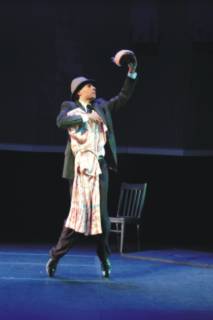| Monk's
Mood Process Notes
Monk’s Mood explores tap dance as
a narrative form of storytelling augmented by digital
technologies. "One of my concerns is how to use technology
to enhance theatrical storytelling, and not simply as
a sort of gimmick," said DeFrantz, a faculty member
in the Music and Theater Arts department at MIT.
The project has been supported by a generous grant from the Massachusetts Institute of Technology Provost's Fund, and developed in residencies at the Rockefeller Study Center at Bellagio, Italy, and at Stanford University. Monk's Mood has been presented in previous versions at MIT, Hampshire College, Connecticut College, Stanford University, as part of the Intersections II conference at New World Theater at Umass Amherst, and as a featured selection of the New Haven International Festival of the Arts. Portions of the work have been shown in New Delhi, Paris, Johannesburg, and as a selection at the 2008 Capetown International Ballet Competition Gala.
"This piece also illustrates the
potential of tap dance as a lyrical form of storytelling,"
DeFrantz said. "I intend to explore narrative possibilities
within tap, a dance form typically noted for its flashy
tricks and rhythmic aspects."
The 50-minute work employs high-tech set
pieces designed by MIT and Stanford graduate students
to trigger sound and video images during the performance.
Foot buttons, originally designed for the video game "Dance
Dance Revolution," are built into wooden platforms
on the stage. Throughout the piece, DeFrantz controls
sound and imagery through his dancing.
Monk's Mood arose from DeFrantz's fascination
with Monk's unique way of hearing and playing. "Monk
took a basic tonality, such as a chord progression, and
made it strange. When I dance the way that he played,
even simple tap steps become very, very strange. In a
way, my steps are analogous to his piano keys; I'm trying
to find his rhythms with my feet," the choreographer
said.
Creating TAP DANCE phrases in response to MONK’s evocative and erratic playing inspired the WALL OF SOUND approach that often works against the basic pulse of the music. MONK’S MOOD began as an exploration of Monk’s life and music, but became a meditation on the CREATIVE PROCESS itself. As often as not, the work considers the desire to COMPOSE. What are the terms of isolation that allow artists to create something from nothing, and how does that solitude affect their well-being? The digital pads on the stage are connected by computers to audio and video mixers to generate sound and image. Dance steps trigger the sound and imagery that accompany the story of Monk’s life. The PADS take on the character of the BARONESS; become the JAZZ ALL STARS that Monk performed with, however briefly; and offer a COMPOSITIONAL DEVICE for his ode to Billie Holiday.
SLIPPAGE: performance|culture|technology
.
|

